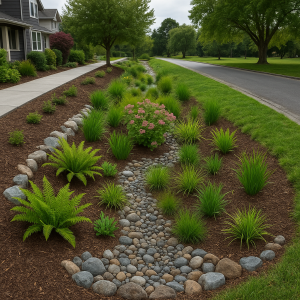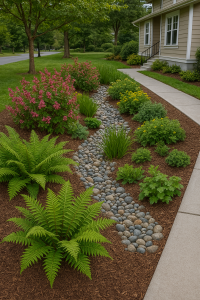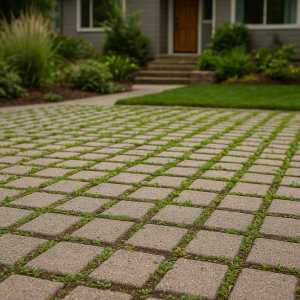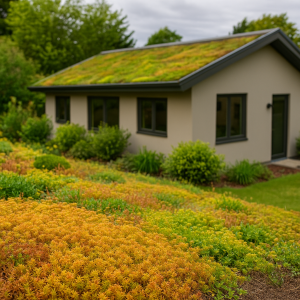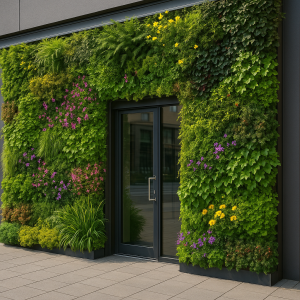Victoria, British Columbia, is known for its lush green spaces, abundant rainfall, and progressive approach to sustainability. As urban development continues, the demand for eco-friendly landscaping solutions that manage rainwater and promote biodiversity has never been greater. Fortunately, green infrastructure practices like rain gardens, living walls, and permeable paving are not only practical but also beautiful ways to create resilient outdoor environments in our coastal city.
In this blog, we’ll explore how these nature-based solutions are actively helping manage stormwater in Victoria’s climate, while also enhancing ecological health, supporting native species, and adding value to commercial and residential properties alike.
1. Rain Gardens: Natural Stormwater Filters
Rain gardens are shallow, landscaped depressions designed to capture and absorb runoff from roofs, streets, and sidewalks. In a region like Victoria, where winter rainfall is substantial, rain gardens serve as a natural filtration system. In turn, they help reduce the burden on stormwater infrastructure.
Why do they work in Victoria?
-
They are ideal for the city’s clay-rich soils with proper amendments.
-
They can be planted with native species such as sword ferns, red-flowering currant, and sedges that thrive in both wet and dry periods.
-
They reduce localized flooding and protect water quality in nearby streams and oceanfront areas.
For example, IslandEarth Landscape Company has incorporated rain gardens into multi-unit residential developments in Victoria’s Rockland and Fernwood neighbourhoods. In doing so, they blend aesthetics with function while significantly improving site drainage.
2. Bioswales: Green Channels for Urban Flow
Much like rain gardens, bioswales are vegetated channels that slow and direct water runoff. They are often used along roadways, parking lots, or driveways. Because of their structure, they’re especially handy for large commercial properties looking to minimize impermeable surfaces.
Benefits:
-
They capture pollutants before they reach local waterways.
-
They reduce erosion and pooling in heavy rain events.
-
They can double as visually appealing green corridors.
In the context of Victoria, bioswales are increasingly used in city-approved landscape designs. In particular, they are being adopted in newly built public infrastructure projects like park-and-ride lots and civic buildings.
3. Permeable Paving: Hard Surfaces with a Soft Impact
Traditional concrete and asphalt don’t allow water to infiltrate, which leads to runoff and drainage issues. By contrast, permeable paving alternatives—like porous asphalt, pavers with grass joints, or gravel grids—let water soak through the surface and into the ground.
In Victoria, permeable paving is a smart choice because:
-
It aligns with city stormwater management goals.
-
It qualifies for Victoria’s Stormwater Utility incentive program.
-
It reduces ice build-up during shoulder seasons by improving drainage.
As a result, businesses and homeowners who replace driveways or patios with permeable paving may be eligible for reduced utility fees and can help support groundwater recharge.
4. Green Roofs: Elevated Ecosystems
Green roofs involve planting vegetation over a waterproof layer on top of buildings. These living rooftops offer insulation, reduce urban heat island effects, and absorb rainfall before it hits the ground.
Climate fit for Victoria:
-
The city’s temperate climate supports year-round greenery with minimal irrigation.
-
They are ideal for multi-family units, office buildings, and educational campuses.
-
They can extend roof lifespan while increasing property value.
For instance, several Victoria schools and civic buildings have begun piloting green roofs. Through these initiatives, they aim to reduce heating costs and contribute to their sustainability goals.
5. Living Walls: Vertical Biodiversity Boosters
Living—or green—walls are vertical gardens installed on exterior or interior walls. In urban Victoria, where horizontal space is often limited, living walls offer a stunning and space-efficient way to introduce more greenery into the built environment.
Advantages:
-
They help insulate buildings and reduce energy usage.
-
They provide pollinator habitat and support biodiversity.
-
They reduce noise pollution in dense urban areas.
Notably, IslandEarth Landscape has designed living walls for commercial storefronts and restaurant patios in downtown Victoria. In these cases, the walls serve as both environmental assets and artistic focal points.
Why It Matters: Supporting Victoria’s Green Vision
Victoria’s stormwater utility incentive encourages property owners to implement systems that reduce runoff and improve infiltration. Moreover, eco-friendly landscaping qualifies for these incentives and aligns with the city’s broader climate adaptation and biodiversity goals.
Therefore, when property developers and commercial clients invest in these sustainable features, they’re not just beautifying their landscapes—they’re actively contributing to a resilient, environmentally responsible, and future-ready city.
A Greener Way Forward
From rain gardens to living walls, eco-friendly landscaping solutions are no longer fringe ideas—they’re the foundation of responsible design in Victoria. As climate patterns shift, and cities strive to protect their natural ecosystems, adopting green infrastructure becomes both practical and visionary.
Ultimately, for commercial property owners, developers, and landscape professionals, integrating these solutions is an investment in long-term value, community health, and environmental stewardship. The team at IslandEarth Landscape is proud to be part of this green transformation—designing landscapes that work with nature, not against it.
